Report on Different Types of Entrepreneurial Ventures, Unit 9, 2021
VerifiedAdded on 2021/08/30
|23
|6122
|319
Report
AI Summary
This report, designed as a business manual, explores various types of entrepreneurial ventures, including small businesses, scalable startups, social enterprises, and high-growth firms. It delves into the similarities and differences between these ventures, examining business environments and utilizing models such as PESTLE and VRIO for analysis. The report further investigates the impact of micro and small businesses on the economy, particularly within the context of Vietnam, highlighting their contributions to innovation and job creation. It concludes by emphasizing the importance of small businesses and startups at different business levels, providing a comprehensive overview of the entrepreneurial landscape and its significance.

ASSIGNMENT 1 FRONT SHEET
Qualification BTEC Level 4 HND Diploma in Business
Unit number and title Unit 9: Entrepreneurship and Small Business Management
Submission date 13/08/2021 Date received (1 st submission)
Re-submission date Date received (2 nd submission)
Student name Ho Pham Linh Nhu Student ID TBS21
Class GBS0904A Assessor name Truon
Student declaration
I certify that the assignment submission is entirely my own work and I fully understand the consequences of
making a false declaration is a form of malpractice.
Student’s signature:
Grading grid
P1 P2 P3 P4 M1 M2 D1
Qualification BTEC Level 4 HND Diploma in Business
Unit number and title Unit 9: Entrepreneurship and Small Business Management
Submission date 13/08/2021 Date received (1 st submission)
Re-submission date Date received (2 nd submission)
Student name Ho Pham Linh Nhu Student ID TBS21
Class GBS0904A Assessor name Truon
Student declaration
I certify that the assignment submission is entirely my own work and I fully understand the consequences of
making a false declaration is a form of malpractice.
Student’s signature:
Grading grid
P1 P2 P3 P4 M1 M2 D1
Paraphrase This Document
Need a fresh take? Get an instant paraphrase of this document with our AI Paraphraser

2
Summative Feedbacks: Resubmission Feedbacks:
Grade: Assessor Signature: Date:
Internal Verifier’s Comments:
Signature & Date:
Summative Feedbacks: Resubmission Feedbacks:
Grade: Assessor Signature: Date:
Internal Verifier’s Comments:
Signature & Date:

3
⊘ This is a preview!⊘
Do you want full access?
Subscribe today to unlock all pages.

Trusted by 1+ million students worldwide
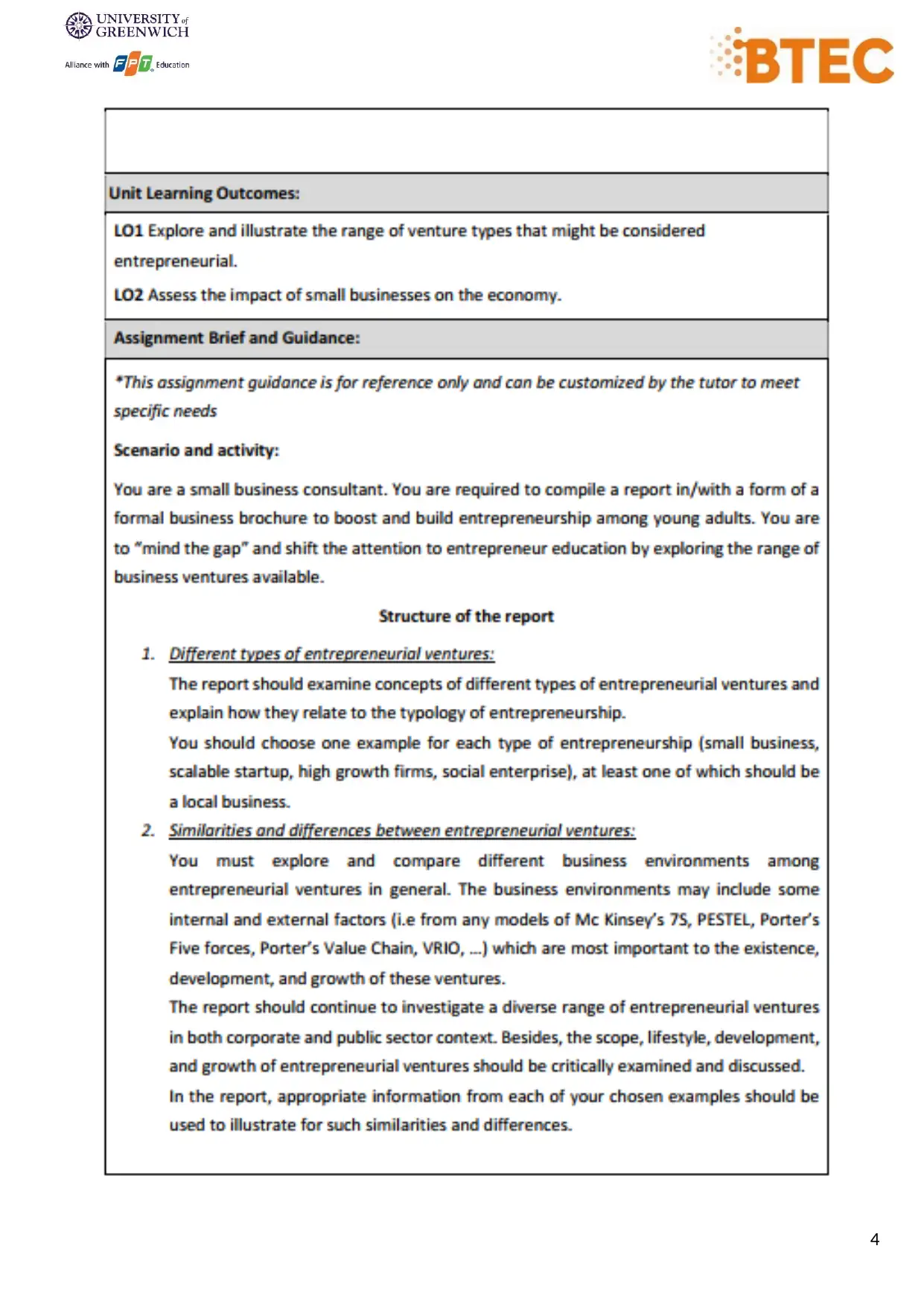
4
Paraphrase This Document
Need a fresh take? Get an instant paraphrase of this document with our AI Paraphraser

5
Table of Contents
I. Introduction: ................................................................................................................................................ 6
II. Body: ............................................................................................................................................................ 6
A. Different Types of Entrepreneurial Ventures ........................................................................................... 6
1. Small Business, Scalable Startup, Social Enterprise, High-growth Firm: ........................................... 6
2. Typology of Entrepreneurship: .......................................................................................................... 7
B. Similarities and Differences between Entrepreneurial Ventures: ............................................................ 9
1. Business Environments of Entrepreneurship in General Context ..................................................... 9
2. External Factors Clarifying – PESTLE Model .................................................................................... 10
3. Internal Factors of the Entrepreneurs – VRIO Strategy ................................................................... 10
C. Micro and Small Businesses Affect the Economy ................................................................................... 12
1. Definition of Micro/Small Businesses Entrepreneurship Type in Vietnam ..................................... 12
2. Their Contributions to the Economy ............................................................................................... 13
D. The Importance of Small Businesses, Startups: .................................................................................. 16
1. Triip.Me Brief ................................................................................................................................... 16
2. Small Talk with the Leaders ............................................................................................................. 16
3. The Importance of Small Businesses/Startup to Different Business Levels .................................... 18
III. Conclusion: ................................................................................................................................................. 20
IV. References: ................................................................................................................................................. 21
Table of Contents
I. Introduction: ................................................................................................................................................ 6
II. Body: ............................................................................................................................................................ 6
A. Different Types of Entrepreneurial Ventures ........................................................................................... 6
1. Small Business, Scalable Startup, Social Enterprise, High-growth Firm: ........................................... 6
2. Typology of Entrepreneurship: .......................................................................................................... 7
B. Similarities and Differences between Entrepreneurial Ventures: ............................................................ 9
1. Business Environments of Entrepreneurship in General Context ..................................................... 9
2. External Factors Clarifying – PESTLE Model .................................................................................... 10
3. Internal Factors of the Entrepreneurs – VRIO Strategy ................................................................... 10
C. Micro and Small Businesses Affect the Economy ................................................................................... 12
1. Definition of Micro/Small Businesses Entrepreneurship Type in Vietnam ..................................... 12
2. Their Contributions to the Economy ............................................................................................... 13
D. The Importance of Small Businesses, Startups: .................................................................................. 16
1. Triip.Me Brief ................................................................................................................................... 16
2. Small Talk with the Leaders ............................................................................................................. 16
3. The Importance of Small Businesses/Startup to Different Business Levels .................................... 18
III. Conclusion: ................................................................................................................................................. 20
IV. References: ................................................................................................................................................. 21
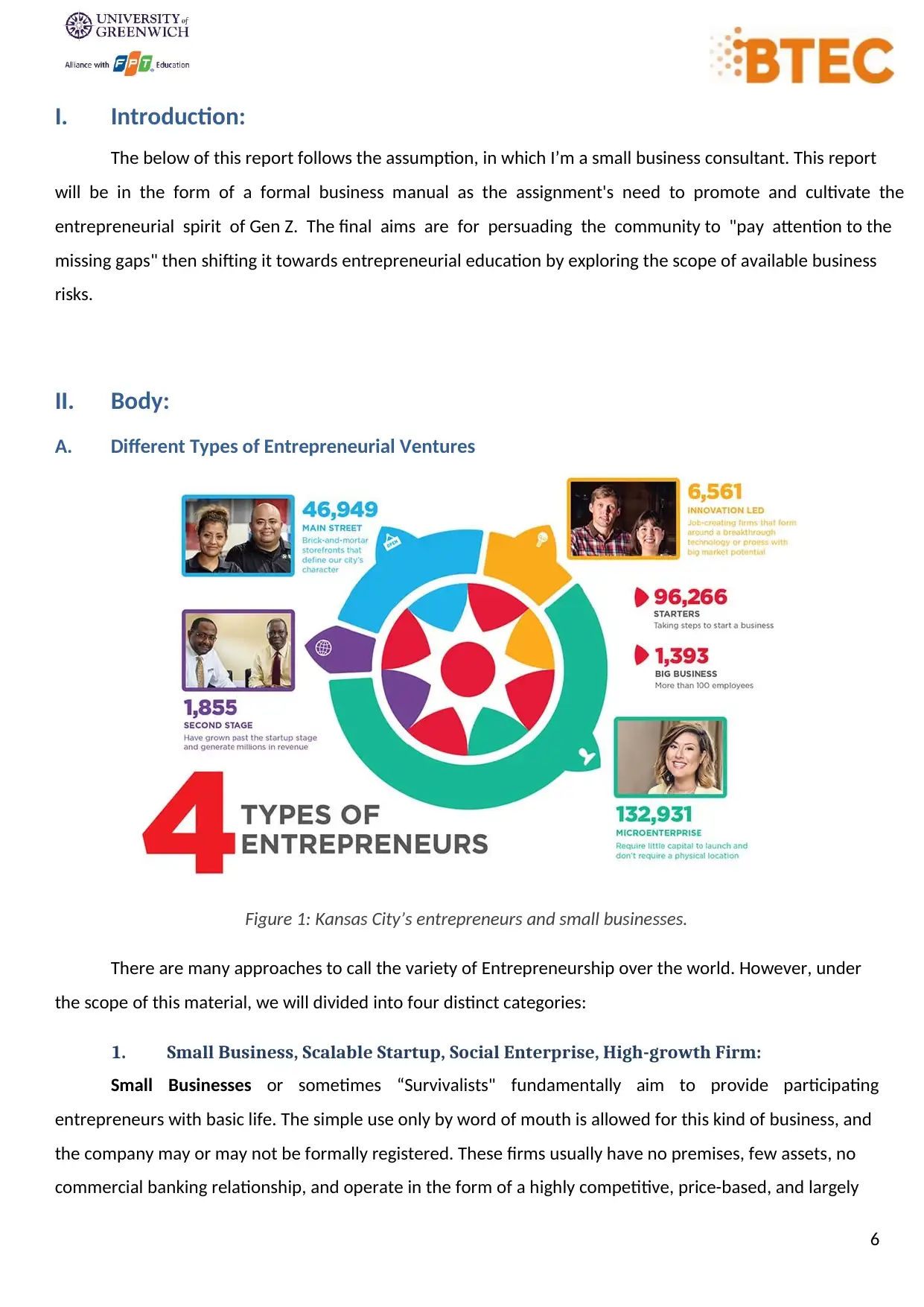
6
I. Introduction:
The below of this report follows the assumption, in which I’m a small business consultant. This report
will be in the form of a formal business manual as the assignment's need to promote and cultivate the
entrepreneurial spirit of Gen Z. The final aims are for persuading the community to "pay attention to the
missing gaps" then shifting it towards entrepreneurial education by exploring the scope of available business
risks.
II. Body:
A. Different Types of Entrepreneurial Ventures
Figure 1: Kansas City’s entrepreneurs and small businesses.
There are many approaches to call the variety of Entrepreneurship over the world. However, under
the scope of this material, we will divided into four distinct categories:
1. Small Business, Scalable Startup, Social Enterprise, High-growth Firm:
Small Businesses or sometimes “Survivalists" fundamentally aim to provide participating
entrepreneurs with basic life. The simple use only by word of mouth is allowed for this kind of business, and
the company may or may not be formally registered. These firms usually have no premises, few assets, no
commercial banking relationship, and operate in the form of a highly competitive, price-based, and largely
I. Introduction:
The below of this report follows the assumption, in which I’m a small business consultant. This report
will be in the form of a formal business manual as the assignment's need to promote and cultivate the
entrepreneurial spirit of Gen Z. The final aims are for persuading the community to "pay attention to the
missing gaps" then shifting it towards entrepreneurial education by exploring the scope of available business
risks.
II. Body:
A. Different Types of Entrepreneurial Ventures
Figure 1: Kansas City’s entrepreneurs and small businesses.
There are many approaches to call the variety of Entrepreneurship over the world. However, under
the scope of this material, we will divided into four distinct categories:
1. Small Business, Scalable Startup, Social Enterprise, High-growth Firm:
Small Businesses or sometimes “Survivalists" fundamentally aim to provide participating
entrepreneurs with basic life. The simple use only by word of mouth is allowed for this kind of business, and
the company may or may not be formally registered. These firms usually have no premises, few assets, no
commercial banking relationship, and operate in the form of a highly competitive, price-based, and largely
⊘ This is a preview!⊘
Do you want full access?
Subscribe today to unlock all pages.

Trusted by 1+ million students worldwide
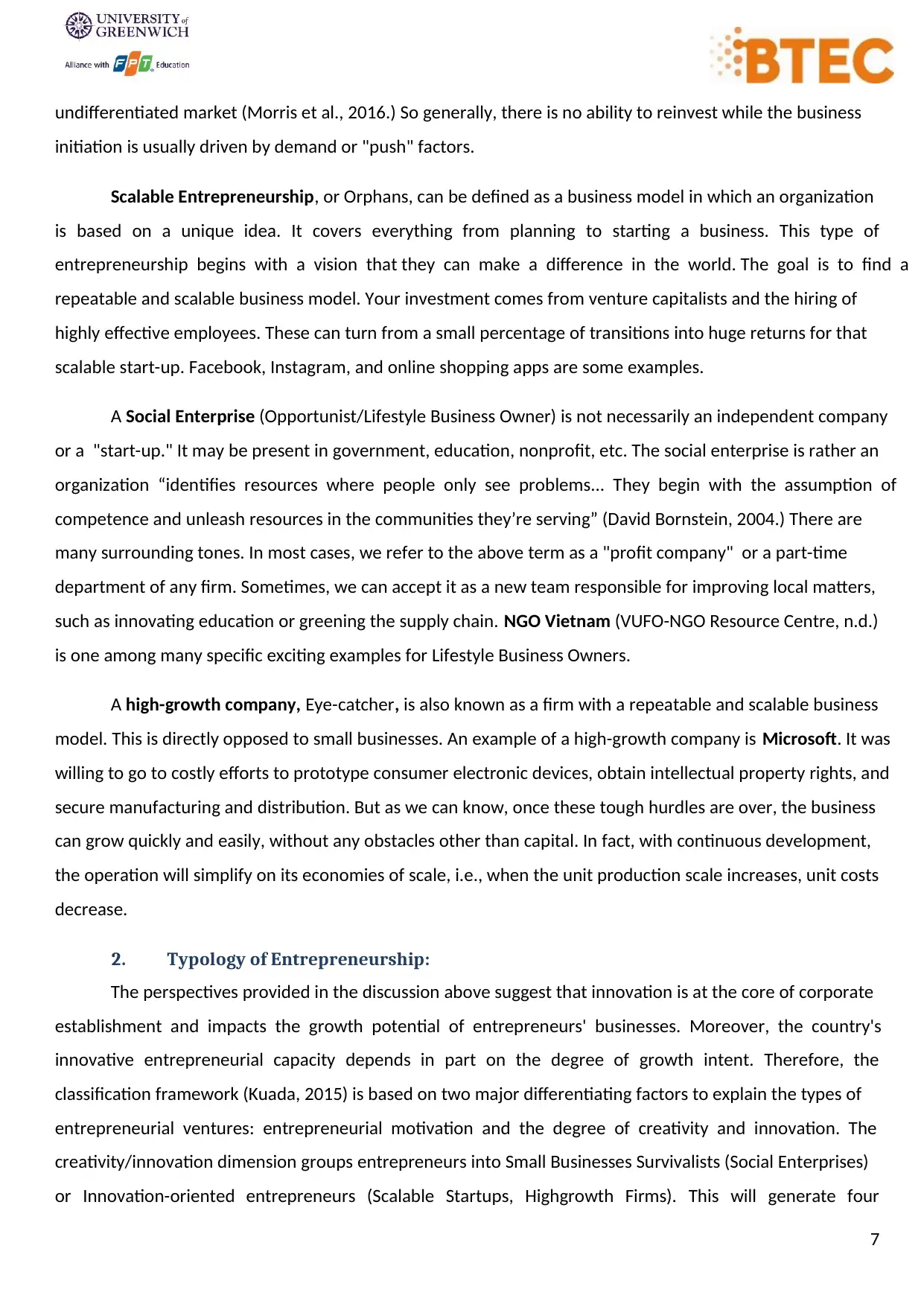
7
undifferentiated market (Morris et al., 2016.) So generally, there is no ability to reinvest while the business
initiation is usually driven by demand or "push" factors.
Scalable Entrepreneurship, or Orphans, can be defined as a business model in which an organization
is based on a unique idea. It covers everything from planning to starting a business. This type of
entrepreneurship begins with a vision that they can make a difference in the world. The goal is to find a
repeatable and scalable business model. Your investment comes from venture capitalists and the hiring of
highly effective employees. These can turn from a small percentage of transitions into huge returns for that
scalable start-up. Facebook, Instagram, and online shopping apps are some examples.
A Social Enterprise (Opportunist/Lifestyle Business Owner) is not necessarily an independent company
or a "start-up." It may be present in government, education, nonprofit, etc. The social enterprise is rather an
organization “identifies resources where people only see problems... They begin with the assumption of
competence and unleash resources in the communities they’re serving” (David Bornstein, 2004.) There are
many surrounding tones. In most cases, we refer to the above term as a "profit company" or a part-time
department of any firm. Sometimes, we can accept it as a new team responsible for improving local matters,
such as innovating education or greening the supply chain. NGO Vietnam (VUFO-NGO Resource Centre, n.d.)
is one among many specific exciting examples for Lifestyle Business Owners.
A high-growth company, Eye-catcher, is also known as a firm with a repeatable and scalable business
model. This is directly opposed to small businesses. An example of a high-growth company is Microsoft. It was
willing to go to costly efforts to prototype consumer electronic devices, obtain intellectual property rights, and
secure manufacturing and distribution. But as we can know, once these tough hurdles are over, the business
can grow quickly and easily, without any obstacles other than capital. In fact, with continuous development,
the operation will simplify on its economies of scale, i.e., when the unit production scale increases, unit costs
decrease.
2. Typology of Entrepreneurship:
The perspectives provided in the discussion above suggest that innovation is at the core of corporate
establishment and impacts the growth potential of entrepreneurs' businesses. Moreover, the country's
innovative entrepreneurial capacity depends in part on the degree of growth intent. Therefore, the
classification framework (Kuada, 2015) is based on two major differentiating factors to explain the types of
entrepreneurial ventures: entrepreneurial motivation and the degree of creativity and innovation. The
creativity/innovation dimension groups entrepreneurs into Small Businesses Survivalists (Social Enterprises)
or Innovation-oriented entrepreneurs (Scalable Startups, Highgrowth Firms). This will generate four
undifferentiated market (Morris et al., 2016.) So generally, there is no ability to reinvest while the business
initiation is usually driven by demand or "push" factors.
Scalable Entrepreneurship, or Orphans, can be defined as a business model in which an organization
is based on a unique idea. It covers everything from planning to starting a business. This type of
entrepreneurship begins with a vision that they can make a difference in the world. The goal is to find a
repeatable and scalable business model. Your investment comes from venture capitalists and the hiring of
highly effective employees. These can turn from a small percentage of transitions into huge returns for that
scalable start-up. Facebook, Instagram, and online shopping apps are some examples.
A Social Enterprise (Opportunist/Lifestyle Business Owner) is not necessarily an independent company
or a "start-up." It may be present in government, education, nonprofit, etc. The social enterprise is rather an
organization “identifies resources where people only see problems... They begin with the assumption of
competence and unleash resources in the communities they’re serving” (David Bornstein, 2004.) There are
many surrounding tones. In most cases, we refer to the above term as a "profit company" or a part-time
department of any firm. Sometimes, we can accept it as a new team responsible for improving local matters,
such as innovating education or greening the supply chain. NGO Vietnam (VUFO-NGO Resource Centre, n.d.)
is one among many specific exciting examples for Lifestyle Business Owners.
A high-growth company, Eye-catcher, is also known as a firm with a repeatable and scalable business
model. This is directly opposed to small businesses. An example of a high-growth company is Microsoft. It was
willing to go to costly efforts to prototype consumer electronic devices, obtain intellectual property rights, and
secure manufacturing and distribution. But as we can know, once these tough hurdles are over, the business
can grow quickly and easily, without any obstacles other than capital. In fact, with continuous development,
the operation will simplify on its economies of scale, i.e., when the unit production scale increases, unit costs
decrease.
2. Typology of Entrepreneurship:
The perspectives provided in the discussion above suggest that innovation is at the core of corporate
establishment and impacts the growth potential of entrepreneurs' businesses. Moreover, the country's
innovative entrepreneurial capacity depends in part on the degree of growth intent. Therefore, the
classification framework (Kuada, 2015) is based on two major differentiating factors to explain the types of
entrepreneurial ventures: entrepreneurial motivation and the degree of creativity and innovation. The
creativity/innovation dimension groups entrepreneurs into Small Businesses Survivalists (Social Enterprises)
or Innovation-oriented entrepreneurs (Scalable Startups, Highgrowth Firms). This will generate four
Paraphrase This Document
Need a fresh take? Get an instant paraphrase of this document with our AI Paraphraser
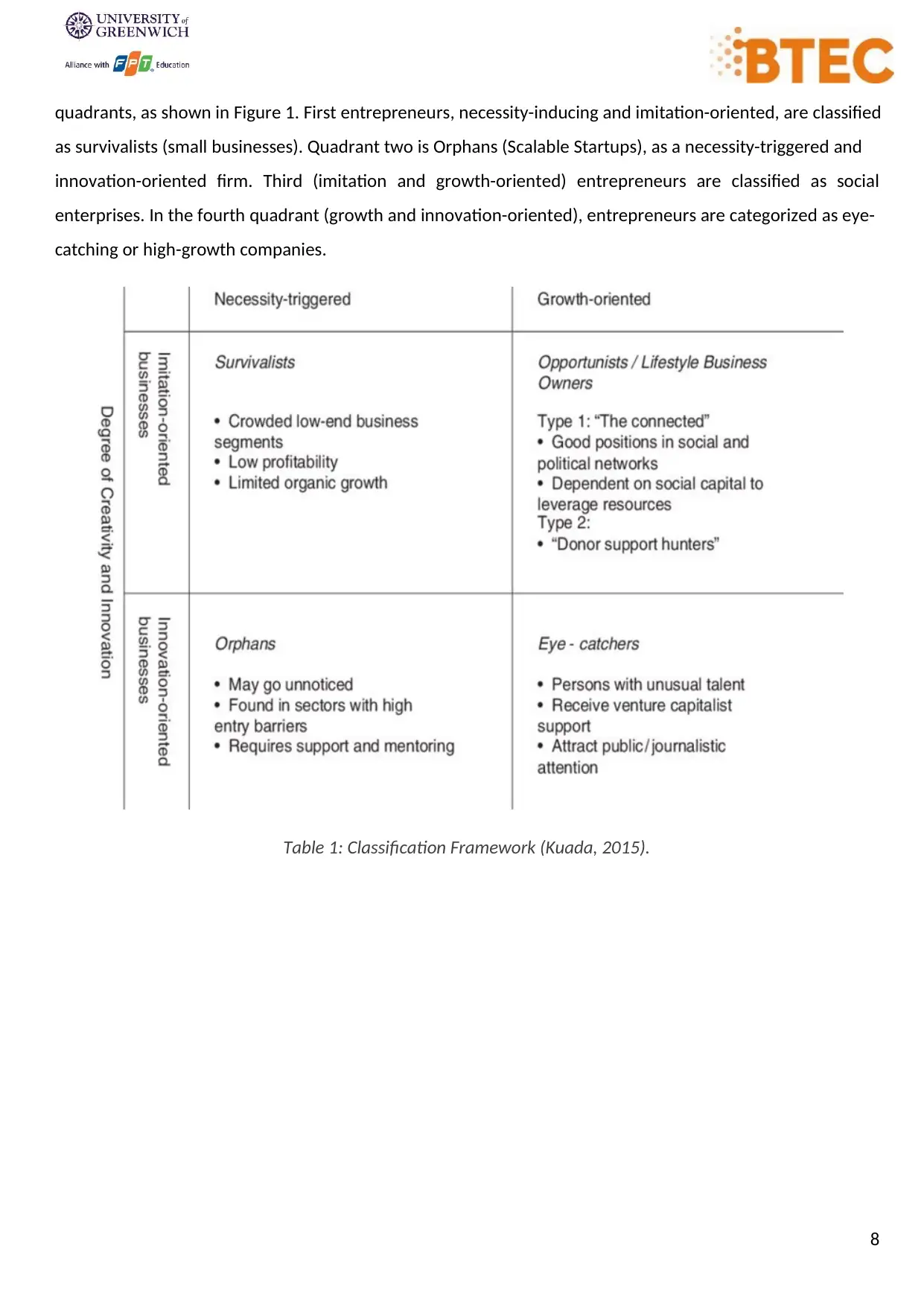
8
quadrants, as shown in Figure 1. First entrepreneurs, necessity-inducing and imitation-oriented, are classified
as survivalists (small businesses). Quadrant two is Orphans (Scalable Startups), as a necessity-triggered and
innovation-oriented firm. Third (imitation and growth-oriented) entrepreneurs are classified as social
enterprises. In the fourth quadrant (growth and innovation-oriented), entrepreneurs are categorized as eye-
catching or high-growth companies.
Table 1: Classification Framework (Kuada, 2015).
quadrants, as shown in Figure 1. First entrepreneurs, necessity-inducing and imitation-oriented, are classified
as survivalists (small businesses). Quadrant two is Orphans (Scalable Startups), as a necessity-triggered and
innovation-oriented firm. Third (imitation and growth-oriented) entrepreneurs are classified as social
enterprises. In the fourth quadrant (growth and innovation-oriented), entrepreneurs are categorized as eye-
catching or high-growth companies.
Table 1: Classification Framework (Kuada, 2015).

9
B. Similarities and Differences between Entrepreneurial Ventures:
To enter the entrepreneurial industry, participants, at first, must have a clear understanding of the
surrounding conditions and forces. According to Professional Academy (n.d.), we have the brief over many
different kinds of environments.
1. Business Environments of Entrepreneurship in General Context
Figure 3: The Essential Environments of Entrepreneur Ventures.
The microenvironment is all within reach of the company. These are the forces involved in the day-to-
day operation of the business, and the business has some control over these areas. Here is some distinctive
aspects to recognize those four kinds of entrepreneurs:
Small Businesses Scalable Startups Social Enterprises High-growth Firms
Small Small or Medium Small, Medium or Large Medium or Large
Reactive Tactical Strategic, can be
proactive (global case)
Strategic and proactive
No specific objective or
only one
Give what customers
need
Develops the framework
of operations
Innovative is essential
Seek to earn capital
Provide products or
services support society
Sustainable
development objective
Provide new core-built
products
B. Similarities and Differences between Entrepreneurial Ventures:
To enter the entrepreneurial industry, participants, at first, must have a clear understanding of the
surrounding conditions and forces. According to Professional Academy (n.d.), we have the brief over many
different kinds of environments.
1. Business Environments of Entrepreneurship in General Context
Figure 3: The Essential Environments of Entrepreneur Ventures.
The microenvironment is all within reach of the company. These are the forces involved in the day-to-
day operation of the business, and the business has some control over these areas. Here is some distinctive
aspects to recognize those four kinds of entrepreneurs:
Small Businesses Scalable Startups Social Enterprises High-growth Firms
Small Small or Medium Small, Medium or Large Medium or Large
Reactive Tactical Strategic, can be
proactive (global case)
Strategic and proactive
No specific objective or
only one
Give what customers
need
Develops the framework
of operations
Innovative is essential
Seek to earn capital
Provide products or
services support society
Sustainable
development objective
Provide new core-built
products
⊘ This is a preview!⊘
Do you want full access?
Subscribe today to unlock all pages.

Trusted by 1+ million students worldwide
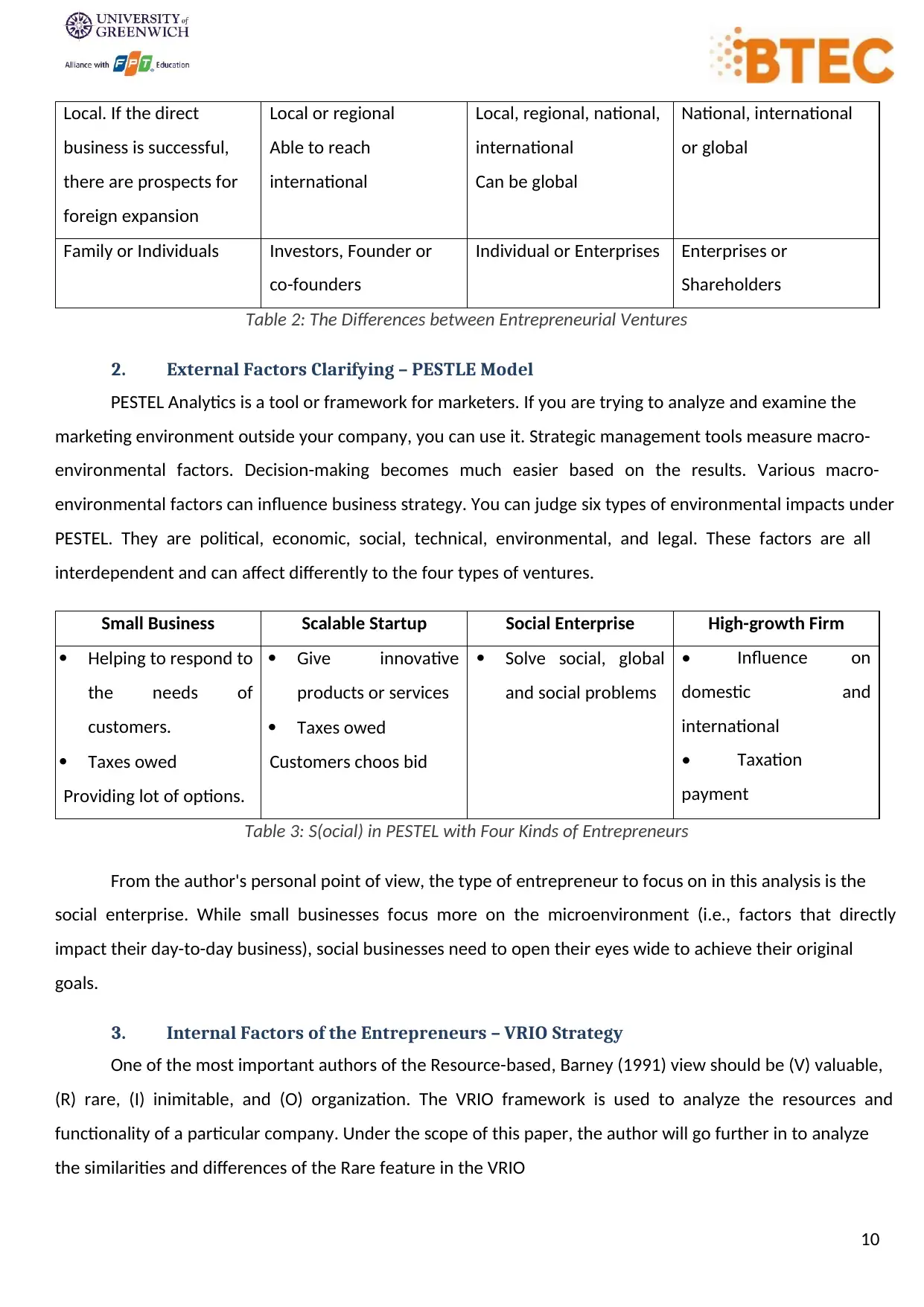
10
Local. If the direct
business is successful,
there are prospects for
foreign expansion
Local or regional
Able to reach
international
Local, regional, national,
international
Can be global
National, international
or global
Family or Individuals Investors, Founder or
co-founders
Individual or Enterprises Enterprises or
Shareholders
Table 2: The Differences between Entrepreneurial Ventures
2. External Factors Clarifying – PESTLE Model
PESTEL Analytics is a tool or framework for marketers. If you are trying to analyze and examine the
marketing environment outside your company, you can use it. Strategic management tools measure macro-
environmental factors. Decision-making becomes much easier based on the results. Various macro-
environmental factors can influence business strategy. You can judge six types of environmental impacts under
PESTEL. They are political, economic, social, technical, environmental, and legal. These factors are all
interdependent and can affect differently to the four types of ventures.
Small Business Scalable Startup Social Enterprise High-growth Firm
Helping to respond to
the needs of
customers.
Taxes owed
Providing lot of options.
Give innovative
products or services
Taxes owed
Customers choos bid
Solve social, global
and social problems
• Influence on
domestic and
international
• Taxation
payment
Table 3: S(ocial) in PESTEL with Four Kinds of Entrepreneurs
From the author's personal point of view, the type of entrepreneur to focus on in this analysis is the
social enterprise. While small businesses focus more on the microenvironment (i.e., factors that directly
impact their day-to-day business), social businesses need to open their eyes wide to achieve their original
goals.
3. Internal Factors of the Entrepreneurs – VRIO Strategy
One of the most important authors of the Resource-based, Barney (1991) view should be (V) valuable,
(R) rare, (I) inimitable, and (O) organization. The VRIO framework is used to analyze the resources and
functionality of a particular company. Under the scope of this paper, the author will go further in to analyze
the similarities and differences of the Rare feature in the VRIO
Local. If the direct
business is successful,
there are prospects for
foreign expansion
Local or regional
Able to reach
international
Local, regional, national,
international
Can be global
National, international
or global
Family or Individuals Investors, Founder or
co-founders
Individual or Enterprises Enterprises or
Shareholders
Table 2: The Differences between Entrepreneurial Ventures
2. External Factors Clarifying – PESTLE Model
PESTEL Analytics is a tool or framework for marketers. If you are trying to analyze and examine the
marketing environment outside your company, you can use it. Strategic management tools measure macro-
environmental factors. Decision-making becomes much easier based on the results. Various macro-
environmental factors can influence business strategy. You can judge six types of environmental impacts under
PESTEL. They are political, economic, social, technical, environmental, and legal. These factors are all
interdependent and can affect differently to the four types of ventures.
Small Business Scalable Startup Social Enterprise High-growth Firm
Helping to respond to
the needs of
customers.
Taxes owed
Providing lot of options.
Give innovative
products or services
Taxes owed
Customers choos bid
Solve social, global
and social problems
• Influence on
domestic and
international
• Taxation
payment
Table 3: S(ocial) in PESTEL with Four Kinds of Entrepreneurs
From the author's personal point of view, the type of entrepreneur to focus on in this analysis is the
social enterprise. While small businesses focus more on the microenvironment (i.e., factors that directly
impact their day-to-day business), social businesses need to open their eyes wide to achieve their original
goals.
3. Internal Factors of the Entrepreneurs – VRIO Strategy
One of the most important authors of the Resource-based, Barney (1991) view should be (V) valuable,
(R) rare, (I) inimitable, and (O) organization. The VRIO framework is used to analyze the resources and
functionality of a particular company. Under the scope of this paper, the author will go further in to analyze
the similarities and differences of the Rare feature in the VRIO
Paraphrase This Document
Need a fresh take? Get an instant paraphrase of this document with our AI Paraphraser

11
Small Business Scalable Startup Social Enterprise High-growth Firm
SIMILIARITIES:
The rarity value is always a highlight ponit in no matter what kinds of Entrepreneurs
It help upgrading the position of customers’ attentions of that firm, create a exploration that can
turn the entrepreneur’s life into next page
The Monkey in Black’s starting point was just the Small Business that offer baverages such as
Tenren, Tien Huong, Bobapop,... However after the transformation, which brang out many
marvelous campaigns, practices that envolved in developing social perceptions, Gen Z especially,
in the essential of the mental health. One of it popular activities is “No bra free drinks” was very
famous for a while. Which helped the founder and his brand succeed in becoming a Scalable
Startup
DIFFERENCES:
Rarity is not highly
focusing unless the
founder want to upgrade
his/her business scope in
the economy.
Rarity is seemed as the
fundamental of this kind
of Entrepreneur.
It creates the attention
to the customers, society
and investors.
Almost the social
enterprises has their
common operation path.
However, if the
Entrpreneur want to
bring his/her ideas
further and farther that
should think about
creating the rarity point.
Rarity is potential
needed. Besides that the
business is always
concentrating on R&D
department to keep
growing its innovation
and strength.
Small Business Scalable Startup Social Enterprise High-growth Firm
SIMILIARITIES:
The rarity value is always a highlight ponit in no matter what kinds of Entrepreneurs
It help upgrading the position of customers’ attentions of that firm, create a exploration that can
turn the entrepreneur’s life into next page
The Monkey in Black’s starting point was just the Small Business that offer baverages such as
Tenren, Tien Huong, Bobapop,... However after the transformation, which brang out many
marvelous campaigns, practices that envolved in developing social perceptions, Gen Z especially,
in the essential of the mental health. One of it popular activities is “No bra free drinks” was very
famous for a while. Which helped the founder and his brand succeed in becoming a Scalable
Startup
DIFFERENCES:
Rarity is not highly
focusing unless the
founder want to upgrade
his/her business scope in
the economy.
Rarity is seemed as the
fundamental of this kind
of Entrepreneur.
It creates the attention
to the customers, society
and investors.
Almost the social
enterprises has their
common operation path.
However, if the
Entrpreneur want to
bring his/her ideas
further and farther that
should think about
creating the rarity point.
Rarity is potential
needed. Besides that the
business is always
concentrating on R&D
department to keep
growing its innovation
and strength.

12
C. Micro and Small Businesses Affect the Economy
1. Definition of Micro/Small Businesses Entrepreneurship Type in Vietnam
The definitions surrounding the variety of Entrepreneurship types are also different. As you have seen
in the above figures, micro and small businesses are the largest force, which has the potential role in any
national economies, not only Vietnam. According to Article 6 of Government Decree No. 39/2018/NDCP,
“SMEs have legally registered business organizations. They are divided into three levels: micro, small and
medium-sized (total capital is equivalent to determining total assets) in the company’s balance or Average
labor is the priority criterion)”. The table below shows you the brief.
Table 3: Size and Scope of an Etrepreneur
In the next part, we will concentrate on the trade and service industry to prove that Micro and Small
Businesses do not only ensure the GDP level but also have other marvelous functions which we will go into
deeper right away.
Figure 6: The Index of 3 Core Business Sector and Type of Business
C. Micro and Small Businesses Affect the Economy
1. Definition of Micro/Small Businesses Entrepreneurship Type in Vietnam
The definitions surrounding the variety of Entrepreneurship types are also different. As you have seen
in the above figures, micro and small businesses are the largest force, which has the potential role in any
national economies, not only Vietnam. According to Article 6 of Government Decree No. 39/2018/NDCP,
“SMEs have legally registered business organizations. They are divided into three levels: micro, small and
medium-sized (total capital is equivalent to determining total assets) in the company’s balance or Average
labor is the priority criterion)”. The table below shows you the brief.
Table 3: Size and Scope of an Etrepreneur
In the next part, we will concentrate on the trade and service industry to prove that Micro and Small
Businesses do not only ensure the GDP level but also have other marvelous functions which we will go into
deeper right away.
Figure 6: The Index of 3 Core Business Sector and Type of Business
⊘ This is a preview!⊘
Do you want full access?
Subscribe today to unlock all pages.

Trusted by 1+ million students worldwide
1 out of 23
Related Documents
Your All-in-One AI-Powered Toolkit for Academic Success.
+13062052269
info@desklib.com
Available 24*7 on WhatsApp / Email
![[object Object]](/_next/static/media/star-bottom.7253800d.svg)
Unlock your academic potential
Copyright © 2020–2025 A2Z Services. All Rights Reserved. Developed and managed by ZUCOL.





